Hi Dave. I suppose the most obvious question to ask is; are you doing this as a one off or might you be doing it again in the future?
Having wasted many hours over the years struggling with seized brake tube nuts and the stress of worrying about what to do when the damned thing rounds off or the pipe snaps, I would say that unless it comes away relatively easily don't waste your time piddling about with it. If it's that corroded it would probably benefit from being renewed anyway so just cut it off! If you are trying to save a flex hose but renew the metal pipe to it then if you cut the metal pipe where it enters the tube nut BEFORE you round off the tube nut then you can get a small single hex socket on it and it may well come undone. If not it probably all needs renewed anyway! I found it quite liberating when I was able to take this approach and stop worrying about trying to save hopelessly corroded pipes, nuts and fixings which I knew in my heart I would probably be returning to in 6 months or so! Trying to weld up heavily corroded exhausts comes into the same category! By the way, I personally would not take a blow torch anywhere near flex hoses and wheel cylinders. I've seen it done and gotten away with, but not for me, too much rubber which doesn't like getting very hot.
So, back to the original question, A one off or repeat performance? If a one off, cut the old pipes off and take the whole lot down to your local garage or auto factors and get them to make up new ones, not forgetting you'll need to know what type of flare has to be formed on each end - there's a choice of two - but you can tell that by looking at the flex hose/brake cylinder/etc that the connection is to be made to. Remember too that you need a wee bit of extra length to account for that lost inside the old tube nuts. Then all you've got to do is enjoy yourself bending it all to shape and not cross threading the nuts!
On the other hand if you are likely to be doing this again in the future and especially if that might be more than once then I don't think there's any doubt that buying your own flaring tool is the way to go. You can buy models that are bench mounted, most of the fully professional ones are like this. (although Sykes Pickavant do a thing called the Flaremaster2, which I covet dearly, which can be used on the vehicle - too expensive for me just now though, but I can dream!). If you are working, as I do, in your drive on axle stands then having a tool which can be used on the vehicle is invaluable as it lets you flare the end of a pipe which is still attached by its other end to the vehicle.
So, back in the '60's as I was completing my City and Guilds etc and starting to work in the trade, I bought myself this:

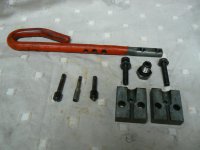
I can't remember the make but I see a very similar tool is still being sold at a very reasonable price. It makes a very nice flare when used with care in both copper and Kunifer tubing. It is not happy with steel tubing although I have done a couple of flares in steel when joining to an original pipe on the car. I think it woild probably fail if you did a lot of steel stuff!
more recently I've become interrested in vintage horticultural machines and old motor cycles. I needed to tackle a 1/4" fuel pipe on a cultivator. The tool above only does 3/16" (4.75mm) dia tubes so I bought this:
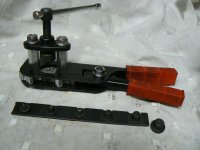
Which is supposed to do from 3/16" up to 1/2" suffice to say I ended up doing it with olives! It does do a nice job of flaring brake pipe though with the one comment that it leaves marks where it grips the outside of the pipe because the jaws are serrated.
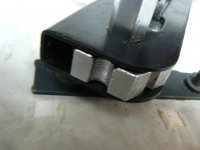
This is not a problem on copper or copper alloy pipes because they do not have an anti corrosion coating but would be a problem on steel where it would destroy the coating. However I don't think this tool would flare steel anyway. So I now have two tools which I can play with but by far and away my favorite is that old friend I bought all those years ago. He and I have spent many happy hours cursing away, with skinned knuckles, freezing our nether regions off under a wide variety of vehicles over the years. I keep the fancy modern one as an emergency spare "just in case". - There seem to be modern versions of my old "pal" still available. People need to consider also that, the majority of these cheaper tools are not suitable for the original steel tubing used by the manufacturers but do a decent enough job on copper.
All you now need is a roll of copper or Kunifer tubing. The copper is a little cheaper to buy and being softer, easier to work so start with it. and some male and female tube nuts. I see an offer on eBay right now for 25ft of copper pipe, 10 male and 10 female tube nuts for nearly £10 and unless you are doing front to rear pipes a 10ft roll will last a long time. Prices vary widely so always do a good search before buying. If you're really obsessed with corrosion you can even buy brass nuts! I did try them but they cost more and are not so widely available so I just use steel ones now. Here are a selection of fixings. The ones on the left are in brass. The middle ones are imperial threaded in steel and the ones on the right are metric threaded in steel. In front of them are a couple of hastily produced examples of flares the one on the left is a double flare done with the newer tool and the one on the right is a single flare done with my faithful old friend!
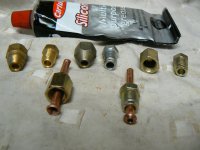
Just behind them all is the tube of silicon grease which I use to lube the die face. The end of the tube needs to be nice and square with the outer edges chamfered to reduce wear on the die. A tube cutter does the job nicely. Just to finish here's a close up of the flares for your delectation!
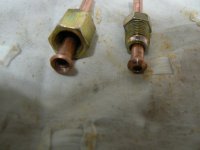
Actually the double flare could be a little nicer but I was being hurried by Mrs Jock who wanted me to help changing the beds as my daughter and her family are arriving for a long weekend with us tonight. Just goes to demonstrate you need to take your time setting these tools up carefully to get the best results. Although, looking at it, I'm sure it would seal just fine! Another advantage of using the copper is that because it's soft even if you don't make an absolutely perfect flare it will deform to fit as you tighten the tube nut so invariably you still get a nice tight dry seal.







